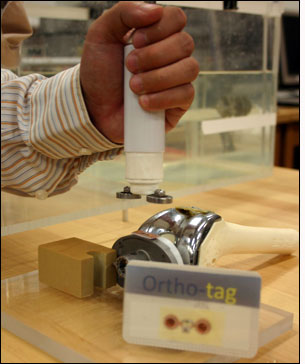Jun 17, 2011Researchers at the University of Pittsburgh have developed a system, known as the Ortho-Tag, including an RFID tag that would be affixed to an orthopedic implant, thereby enabling sensors built into the tag to track the device's health and use within a patient's body. The tag would convey that information via RF signals transmitted through human tissue to a reader placed against a patient's skin. Not only would the system track conditions inside the body surrounding the implant, but it could also identify the device itself in the event of a recall. Moreover, it could help verify that the implants were authentic, and not counterfeit.
The solution was tested at one of the university's laboratories, under the leadership of Marlin Mickle, one of the school's engineering professors. Mickle is also the chairman of the scientific advisory board of Ortho-Tag Inc., the fledgling firm that will commercialize the technology. The company aims to provide the tags to an orthopedic device manufacturer, for attachment to implants as those devices are built. Ortho-Tag would then sell handheld interrogators developed specifically for reading the tags through human tissue, as well as software to manage read data, to physicians and hospitals.

Orthopedic surgeon Lee Berger first developed and patented the tag in early 2008, with the goal of helping patients and physicians track the status of healing around the site of a new implant (see Surgeon Designs System to Monitor Orthopedic Implants and Promote Healing). Berger envisioned a system employing sensors that would measure the physical pressure on a device once it was implanted, as well as the surrounding chemical balance and temperature, in order to identify an infection, as well as determine if the implant had shifted. The sensors would be wired to an RFID chip that would transmit a unique ID number, along with the sensor data, to a handheld reader being used by a physician. Berger built a prototype using passive ultrahigh-frequency (UHF) EPC Gen 2 RFID tags, then began seeking partners to further develop and test the technology's ability to read through the body, prior to marketing it to implant vendors and distributors.
Mickle says he began working with Berger in 2008. The University of Pittsburgh's school of engineering had developed a touch probe that could be utilized to read tags attached to metal, and had also conducted work testing the ability to transmit radio waves through the human body. In May 2010, he says, he secured funding to test and further develop the Ortho-Tag system, using the university's existing touch probe.
Since then, researchers have built a system with modified dual antennas in the touch probe, as well as in the RFID tags. These modified antennas allow the transmission of data through a body, either via UHF or high-frequency (HF) signals. The solution consists of a tag with several built-in sensors, and a touch probe wired to a handheld reader. The size of the commercially available tag has yet to be determined, but the prototype measures approximately 10 millimeters by 5 millimeters (0.4 inch to 0.2 inch). The engineering department is also developing software to interpret tag data as it is received by the touch probe. To read the tag's information, the touch probe would need to be in contact with the patient's skin nearest the point at which a tagged implant is located. This is a benefit for the patient's data security as well, Mickle says, since it would be impossible for someone to read the tag's ID number and sensor data using a standard reader, or to read the tag with a touch probe if it were not pressed against the skin.
Another sensor could be used to track the frequency of the implanted joint's movement, thereby enabling physicians to determine how well the patient was using that joint. If, for example, the implant tag transmitted results indicating that the joint was rarely being used, physicians could address the problem, such as assigning a physical therapist to that individual, or learning more about how pain around the joint might be hindering his or her movement, for example.
The tag could have other functions as well, such as assisting with identifying an implanted joint that has been recalled. Once a joint is implanted, it can often be difficult for patients or physicians to maintain a record of which particular product was inserted. With the Ortho-Tag, a user would capture the tag's ID, which would be linked with details regarding the joint in a back-end database.
Finally, if physicians read the tag before placing the joint within a patient, they could ensure that the product was not counterfeit, since the ID number would indicate that device's manufacturer, when it was built and its expiration date.
The university researchers began testing the system's ability to read through tissue using High-Frequency Structure Simulator (HFSS) software with an electromagnetic field simulation. The next test was conducted by reading tags through tanks of saline solution that mimic human tissue. The third test involved transmitting information through strips of pig skin, which also mimics human flesh. Further testing using human cadavers is a possibility, Mickle says, but that decision will be made in the future by Ortho-Tag's leadership.
"Our goal is commercialization," Mickle says. "The biggest issue now is our search procedure for a CEO of the company." Once hired, that individual will meet with implant providers to generate a partnership with a company that could then market the solution.
Mickle declines to speculate as to when the product would be made commercially available, since several steps must first be completed, including identifying a partnering implant device manufacturer—and that company would then need to earn FDA approval to use the tag. Until then, Ortho-Tag has an alternative device in the works: a passive RFID tag—either an HF 13.56 MHz tag compliant with the ISO 18000-3 standard, or a UHF tag compliant with the EPC Gen 2 standard—embedded in a credit-card sized piece of plastic that could store information about the implant, as well as its manufacturer, when it was built and its serial number. The patient could keep the card in a wallet, Mickle says, noting that the system should be available within a year.
In the meantime, Mickle says, as the researchers test chips, they are examining those with the most memory available—in the range of 8 to 64 kilobits.


